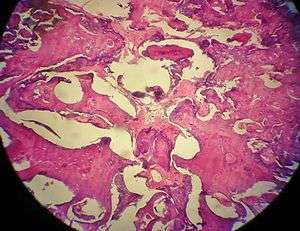Odontoma
An odontoma, also known as an odontome, is a benign tumour[4] linked to tooth development.[5] Specifically, it is a dental hamartoma, meaning that it is composed of normal dental tissue that has grown in an irregular way. It includes both odontogenic hard and soft tissues[1].
| Odontoma | |
|---|---|
| Other names | Odontome[1][2][3] |
 | |
| Specialty | Dentistry |
The average age of people found with an odontoma is 14.[6] The condition is frequently associated with one or more unerupted teeth and is often detected through failure of teeth to erupt at the expected time. Though most cases are found impacted within the jaw there are instances where odontomas have erupted into the oral cavity.[7]
Classification
There are two main types: compound and complex.[8]
- A compound odontoma still has the three separate dental tissues (enamel, dentin and cementum), but may present a lobulated appearance where there is no definitive demarcation of separate tissues between the individual "toothlets" (or denticles). It usually appears in the anterior maxilla.
- The complex type is unrecognizable as dental tissues, usually presenting as a radioopaque area with varying densities. It usually appears in the posterior maxilla or in the mandible.
In addition to the above forms, the dilated odontoma is an infrequent developmental alteration that appears in any area of the dental arches and can affect deciduous, permanent and supernumerary teeth. Dens invaginatus is a developmental anomaly resulting from invagination of a portion of crown forming within the enamel organ during odontogenesis. The most extreme form of dens invaginatus is known as dilated odontoma.
Associated pathology
In the 4th edition of the World Health Organization (WHO) Classification of Head and Neck Tumors (published in January 2017), there is a new section added on odontomas that speculates on a relationship between developing odontomas and ameloblastic fibromas/ameloblastic fibrodentinoma and ameloblastic fibro-odontoma[1].
Epidemiology
Odontomas are thought to be the second most frequent type of odontogenic tumor worldwide (after ameloblastoma), accounting for about 20% of all cases within this relatively uncommon tumor category which shows large geographic variations in incidence.[9]
In 2019, a 7-year-old boy from Tiruvallur district,[10] near Chennai, India with compound odontoma received surgery to remove 526 teeth from his lower right jaw.[11][12]
References
- AK, El-Naggar; JKC, Chan; JR, Grandis; T, Takata; PJ, Slootweg (2017-01-23). WHO Classification of Head and Neck Tumours. ISBN 9789283224389.
- Ireland R (25 March 2010). A Dictionary of Dentistry. Oxford University Press. p. 247. ISBN 978-0-19-953301-5.
- Fletcher CDM (2 April 2013). Diagnostic Histopathology of Tumors: Expert Consult - Online. Elsevier Health Sciences. p. 791. ISBN 978-1-4557-3754-3.
- Junquera L, de Vicente JC, Roig P, Olay S, Rodríguez-Recio O (2005). "Intraosseous odontoma erupted into the oral cavity: an unusual pathology" (PDF). Med Oral Patol Oral Cir Bucal. 10 (3): 248–51. PMID 15876969.
- Odontoma. Dorland's Illustrated Medical Dictionary. Elsevier Health Sciences. 2011. p. 1313. ISBN 978-1-4160-6257-8.
- "Odontogenic tumors". Archived from the original on 2011-07-20. Retrieved 2009-01-04.
- Bhargavan Sarojini S, Khosla E, Varghese T, Johnson Arakkal L (2014). "Eruption of odontomas into the oral cavity: a report of 2 cases". Case Rep Dent. 2014: 4 pages. doi:10.1155/2014/639173. PMC 4037568. PMID 24900927.
- Amado Cuesta S, Gargallo Albiol J, Berini Aytés L, Gay Escoda C (2003). "Review of 61 cases of odontoma. Presentation of an erupted complex odontoma" (PDF). Med Oral. 8 (5): 366–73. PMID 14595262.
- Avelar RL, Primo BT, Pinheiro-Nogueira CB, Studart-Soares EC, de Oliveira RB, Romulo de Medeiros J, Hernandez PA (November 2011). "Worldwide incidence of odontogenic tumors". The Journal of Craniofacial Surgery. 22 (6): 2118–23. doi:10.1097/SCS.0b013e3182323cc7. PMID 22067866.
- Chennai dentists extract 526 teeth from mouth of seven-year-old boy, 31 July 2019, New Indian Express.
- Dunham, Jackie (August 1, 2019). "Boy has surgery to remove 526 teeth 'reminiscent of pearls in an oyster'". CTV News. Retrieved 3 August 2019.
- Saavetha's Surgical and Pathological Excellence in Unmasking 256 Teeth from a Single Site in a Child, 1 August 2019 News from Saavetha Dental College, Chennai. It features photographs and X-ray pictures.
External links
| Classification |
|
|---|